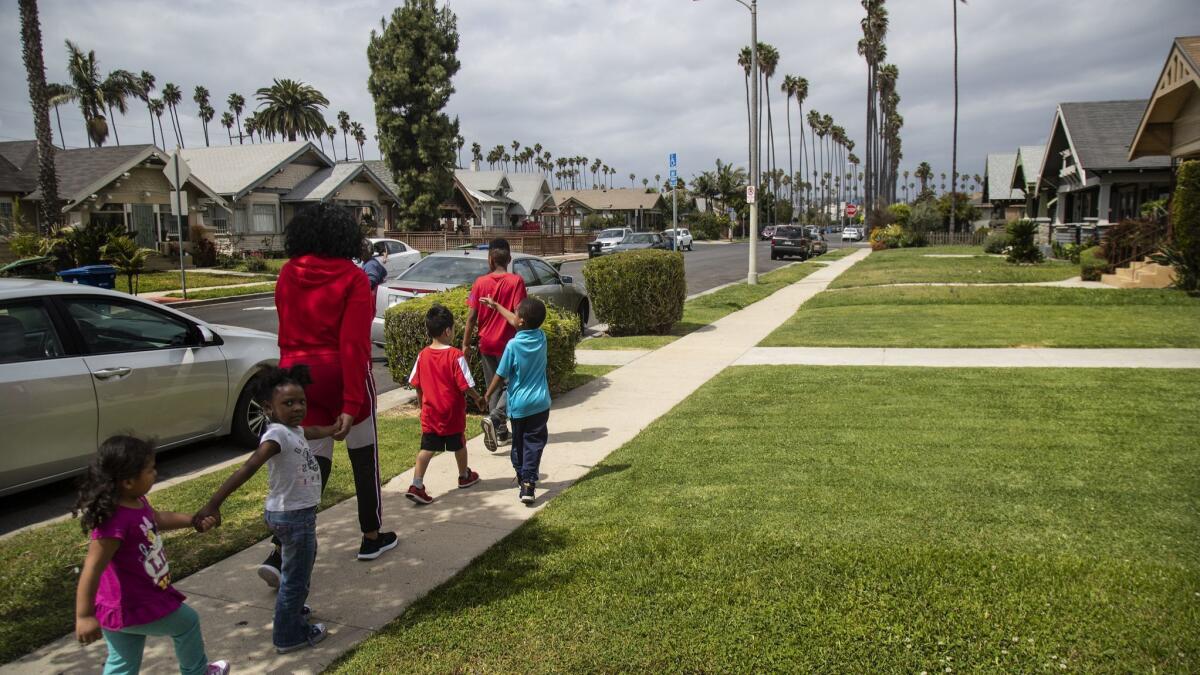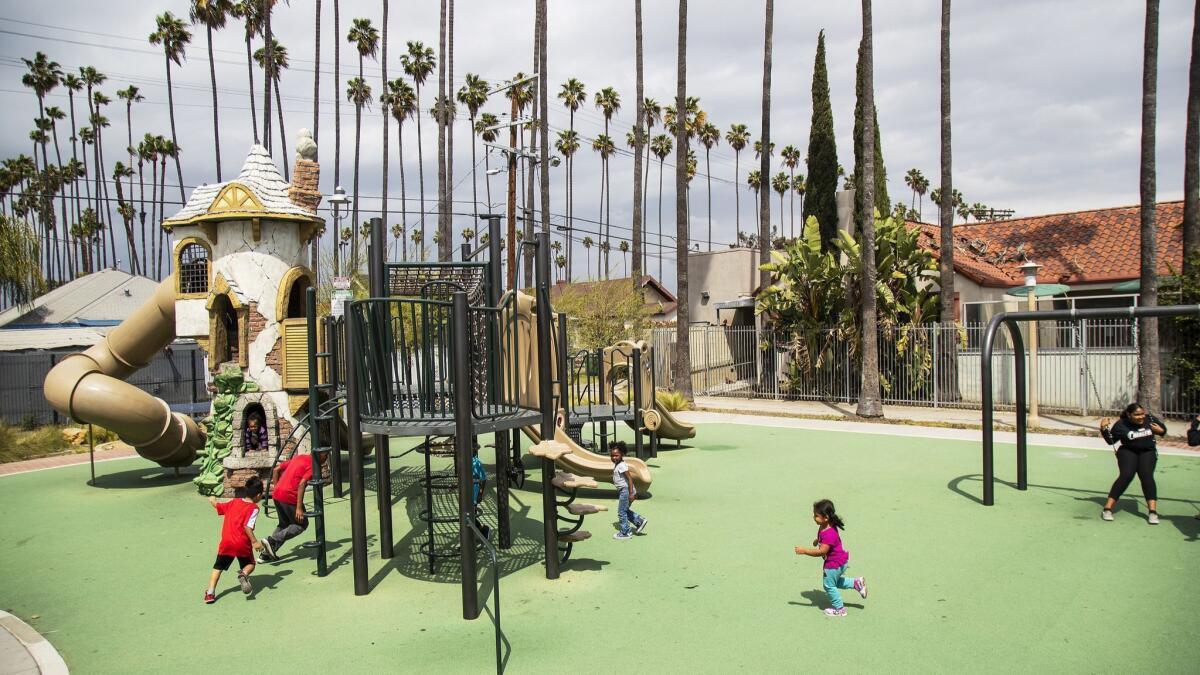Can California boost home building without supercharging gentrification?

- Share via
Along a stretch of South Los Angeles near the Expo light rail line, investment dollars are pouring in.
Landlords outfit vacant apartments with stainless-steel appliances to lift rents, flippers list renovated bungalows for sale at twice what they paid. And as long-term tenants are forced out, development companies build new apartments in a predominantly working-class area that they long shunned.
It’s a story that’s playing out in many California neighborhoods amid a major housing crunch. The solution to displacement of longtime residents, economists say, is to build more homes. But many advocates for lower-income and minority communities, such as those in South Los Angeles, fear that new market-rate buildings will only accelerate gentrification.
A proposed state bill tries to thread that needle. Senate Bill 50 would remove local development restrictions but establish different rules for wealthy and poorer neighborhoods and bar developers from using the bill’s incentives on land where tenants lived for at least the previous seven years.
The proposal, scheduled for a committee vote Wednesday in Sacramento, comes after opposition from low-income community groups helped kill a version last year that zoned for higher-density housing near transit, regardless of demographics.
Many of those groups have remained neutral on the new bill so far. It has broad support among major labor, environmental and developer groups. High hurdles to its passage remain, predominantly because of strong opposition from local governments, including the cities of Los Angeles and San Francisco.
“We are trying to strike a balance,” bill author Sen. Scott Wiener (D-San Francisco) said of differing rules for rich and poorer areas.
California housing bill would allow apartments through swaths of many wealthy cities. »
Under SB 50, wealthy areas near jobs and good schools would have to relax zoning rules to allow low-rise apartments and town homes. Areas near bus stops with frequent service would do the same, while developers could build four- to five-story residential complexes near rail stations.
Neighborhoods zoned single-family wouldn’t be exempt. But certain “sensitive communities” at risk of gentrification would. That exception would last five years to give the neighborhoods time to craft an alternative plan to boost housing supply while protecting residents from displacement.
Wiener said policies may include rent control and protection against demolition and no-fault evictions. Sensitive areas, the senator’s office said, could also require more subsidized housing than the bill mandates and choose what parcels to upzone, as long as the overall boost in potential supply roughly equals that under the bill. If an adequate plan wasn’t created after five years, SB 50 would apply.
A major looming question is how neighborhoods will be picked for the multiyear exemption. Wiener’s office proposes to create a preliminary list using demographic information such as income and percentage of people with crushing rent and mortgage payments. But exactly how communities are ultimately selected must be hashed out.
“How do we designate sensitive communities?” asked Rene Moya, director of Housing Is a Human Right, a project of the AIDS Healthcare Foundation that opposes the bill. “I don’t think the appropriate way is handing off that power to bureaucrats in Sacramento.”
Housing costs have risen across California in recent years. But among the areas with the sharpest upswing are south of the 10 Freeway along the Expo line from USC west to La Cienega Boulevard.
Those South L.A. neighborhoods, including West Adams, Jefferson Park and Exposition Park, were among the city’s first suburbs. Their Craftsman bungalows, stately mansions and Spanish-style houses with red-tile roofs were built to give owners the good life.
But access wasn’t for all. Racist deed covenants barred people from selling homes to non-whites, including the growing number of African Americans who came from the South for good manufacturing jobs. To get around the rules, some blacks bought homes through white intermediaries. Some battled the covenants in court.
When the Supreme Court invalidated race-based restrictions in 1948, middle- and upper-class blacks increasingly moved in. Many whites fled. Over time, the area struggled. The 10 Freeway blasted through West Adams. Factory closings hit South L.A. hard. Residents suffered through gang crime, the effects of redlining and a lack of amenities. Many black families left, seeking a better life in distant suburbs. Latino immigrants moved in, seeking the same.
For decades, investment was hard to attract, particularly after the 1992 riots. Lately that’s changed. Soaring land prices elsewhere boosted interest in less-expensive neighborhoods. Crime rates dropped and public investments arrived. Private dollars flowed in.
Higher-income families, many of them white, have been attracted by relatively affordable single-family homes and the new Expo Line that links an expanding Westside job base with downtown Los Angeles.
New restaurants serving $11 avocado toast or $22 skillet fried chicken opened. Developer Carmel Partners is building a towering mixed-use project, with 1,210 apartments, across from the Expo stop on La Cienega Boulevard.
In Jefferson Park and West Adams, median home prices more than doubled since 2012, to about $700,000, according to Zillow, outpacing a 86% increase for the citywide median price. Rents in the area haven’t grown as fast, but still rose faster than L.A. as a whole.
Najee Thornton, who represents a portion of Jefferson Park on the United Neighborhoods Neighborhood Council, said, “There is some sense of excitement about the investment and opportunities.” But, he added, “I think there is an equal amount [of concern] in trying to preserve the character of the community and continue to serve the folks who have been in the community for 20, 30, 40 years.”
Some have already been forced out. Steven Baldwin and his family received a no-fault eviction notice in 2017 so their landlord could renovate the building. Soon his 4-year-old son began to wake in tears, worried they’d be homeless.
Baldwin, who lived with his parents and two children, secured relocation money, but with escalating rents they couldn’t find a home for everyone. His children now live in the area with his mom and dad, but Baldwin left the state.
“I’m in Vegas now,” he said in a phone interview.
Economists describe the gentrification process as a perverse game of musical chairs. With too few homes, middle-class residents are priced out of their neighborhood and move to lower-cost communities. There, rising costs force out lower-income families, who flee to cheaper neighborhoods and start the process anew. In the end, some end up in the streets.
Research indicates any new housing prevents displacement across a region, particularly when homes are subsidized for lower-income households. But it’s less clear what happens in the neighborhood surrounding a project.
Many residents worry that construction of market-rate homes worsens prospects for low-income residents. A luxury building with ground-floor restaurants might convince wealthier people the area is an “up and coming” place they want to live. It may convince nearby landlords as well, who lift rents to match. Developers may scoop up older apartments to demolish and build fancy homes for new arrivals.
“It creates a speculative effect,” said Doug Smith, a staff attorney with Public Counsel. He said public policies that sap communities of color of investment and opportunity leave them more vulnerable when the capital spigot is suddenly turned on. “The question is not how you keep investment out of sensitive communities, the question is how you invest without displacement.”
When Evan Mast, an economist with the W.E. Upjohn Institute for Employment Research, looked at luxury buildings that opened in gentrifying neighborhoods, he found advertised rents for nearby units rose less than in similar neighborhoods that didn’t have new construction. The preliminary findings indicate new buildings “relieve a bit of the pressure from the surrounding area,” he said. But research on the topic is slim and more is needed, Mast said.
It’s an important question because some of the city’s lower-density zones — including South L.A. — would be prospects for upzoning under SB 50, but also are most vulnerable to displacement. Last week, the Los Angeles City Council voted to oppose SB 50, in part over those concerns.
Sandra Pruitt, 58, lives in a rented single-family house in Jefferson Park. A map from Wiener’s office shows SB 50 wouldn’t affect her block, though it would others nearby. She hopes that doesn’t happen because she likes the single-family character of a neighborhood she’s worked hard to improve.

Pruitt said she got more involved after her son, Jerell, died in a shooting in 2009. She now runs a child-care business out of her home and helped spearhead the renovation of Leslie N. Shaw Park.
The former neighborhood council member said she is happy to finally see new options in the grocery store. But she is frustrated that new offerings seemed to trickle in only as white people arrived. And she worries that families who lived in the area through the lean times won’t be around to enjoy the retail improvements.
“It’s hard to stay in an area we fought to be part of,” she said.
SB 50 first based its definition of sensitive only on poverty and segregation levels — something community groups worried wouldn’t cover many already-gentrifying areas. Wiener plans to offer amendments Wednesday that would tweak the rules to label neighborhoods “potentially sensitive” or not sensitive. In addition to poverty and segregation, factors would include income, unemployment, proximity to pollutants and amount of people paying more than 50% of their incomes on housing.
Potentially sensitive places would be exempt for six months, giving community groups and government agencies a chance to determine which areas should truly have more time to craft anti-displacement protections.
A map from Wiener’s office identifies the vast majority of South L.A. as potentially sensitive. Other areas include all of Boyle Heights and East Hollywood. Most of Hollywood and Echo Park are covered, as is a sliver of Santa Monica near the 10 Freeway.
Wiener has also said he intends for the bill to leave in place L.A.’s own recently enacted program to increase density and subsidized units around transit, rules that apply only to lots now zoned for five or more homes.
Some community advocates believe the sensitive-community protections in Wiener’s bill don’t go far enough. And even community groups that worked with Wiener say that though improved, some of the plan’s crucial issues remain unsettled, such as the process for moving a community from “potentially sensitive” to sensitive.
“I have never seen a difficult bill that doesn’t go through a process until the very end,” Wiener said. “We will have continuing dialogue.”
One part of South L.A. that was left out of the first definition but would be deemed potentially sensitive is Leimert Park, a largely middle-class African American neighborhood that also has many low-income tenants spending more than half their paycheck on housing. Like adjacent areas, the neighborhood has seen prices and rents skyrocket as wealthier, and white, people move into what’s a cultural center for black L.A.
Some worry that as prices rise and development increases, African Americans will lose their place in one of the last South L.A. neighborhoods where they make up a majority.
People of all backgrounds say they moved to Leimert Park, or stayed, to live in a largely single-family neighborhood designed by sons of famed Central Park creator Frederick Law Olmsted. They fear the area, set to gain its own rail stop next year, will lose its small-town charm if apartments are allowed to proliferate.
“This goes completely against the people who designed it,” said Jodi George, 47, who lives in a house her grandparents bought in the 1950s. “It’s like their work is being destroyed.”
Times staff writer Liam Dillon contributed to this report.
Follow me @khouriandrew on Twitter
More to Read
Inside the business of entertainment
The Wide Shot brings you news, analysis and insights on everything from streaming wars to production — and what it all means for the future.
You may occasionally receive promotional content from the Los Angeles Times.










